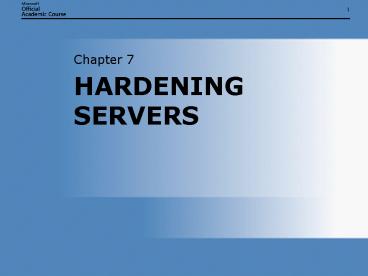HARDENING SERVERS - PowerPoint PPT Presentation
1 / 23
Title:
HARDENING SERVERS
Description:
SERVER HARDENING BEST PRACTICES. Use the Configure Your Server Wizard ... Dynamic Host Configuration Protocol (DHCP) servers running Windows 2000 and ... – PowerPoint PPT presentation
Number of Views:2007
Avg rating:3.0/5.0
Title: HARDENING SERVERS
1
HARDENING SERVERS
- Chapter 7
2
DEFAULT SECURITY TEMPLATES
- Set up Security.inf and DC Security.inf
- Compatws.inf
- Securews.inf and Securedc.inf
- Hisecws.inf and Hisecdc.inf
- Rootsec.inf
- Iesacls.inf
3
DESIGNING SECURITY TEMPLATES
- Create a custom security template for each role,
not each computer - Base custom templates on a default template
- Never modify default security templates
- Apply multiple security templates to computers
with multiple roles
4
SECURITY TEMPLATE SETTINGS
- Account policies
- Local policies
- Event logs
- Group memberships
- Services
- Registry permissions
- File and folder permissions
5
SETTING NOT AVAILABLE IN SECURITY TEMPLATES
- Configuration of Automatic Updates
- Which Microsoft Windows components and
applications are installed - IPSec policies
- Software restrictions
- Wireless network policies
- EFS settings
- Certification Authority (CA) settings
6
CONFIGURING EARLIER VERSIONS OF WINDOWS
- Support Group Policy
- Windows Server 2003
- Windows 2000 Server
- Windows 2000 Professional
- Windows XP Professional
- Support System Policy
- Windows NT 4.0
- Windows 95
- Windows 98
- Windows Me
7
SYSTEM POLICY EDITOR
8
DEPLOYING SECURITY CONFIGURATION WITH GROUP POLICY
- Import templates into Group Policy
- Leverage inheritance
- Filter Group Policy objects (GPOs) with security
groups - Use Windows Management Instrumentation (WMI)
filtering only where necessary
9
SERVER HARDENING BEST PRACTICES
- Use the Configure Your Server Wizard
- Disable unnecessary services
- Develop a process for updating all software
- Change default port numbers
- Use network and host-based firewalls
10
SERVER HARDENING BEST PRACTICES (CONT.)
- Require IPSec
- Place Internet servers in perimeter networks
- Use physical security
- Restrict removable media
- Backup application-specific information
11
SERVER HARDENING BEST PRACTICES (CONT.)
- Audit backups and restores
- Rename default user accounts
- Develop security requirements for
application-specific user databases - Monitor each server role for failures
- Read security guides at http//www.microsoft.com
12
HARDENING DOMAIN CONTROLLERS
- A compromised domain controller can lead to
compromises of domain members - Domain controllers can be identified with a DNS
query - Avoid storing application data in Active
Directory - Create a separate security group for users with
privileges to backup domain controllers - Use source-IP filtering to block domain requests
from external networks
13
REQUIRE DOMAIN CONTROLLER SERVICES
- File Replication Service
- Intersite Messaging
- Kerberos Key Distribution Center
- Netlogon
- Remote Procedure Call (RPC) Locator
- Windows Management Instrumentation
- Windows Time
14
HARDENING DNS SERVERS
- When DNS servers are compromised, attackers can
use them to - Identify internal network resources
- Launch man-in-the-middle attacks
- Perform a denial-of-service (DoS) attack
15
BEST PRACTICES FOR HARDENING DNS SERVERS
- Use Active Directoryintegrated zones. If not
Active Directory integrated - Restrict permissions on zone files
- Use IPSec to protect zone transfers
- Disable recursion where possible
- Use separate internal and Internet servers
- Remove root hints on internal servers
- Allow only secure DNS updates if possible
16
HARDENING DHCP SERVERS
- Dynamic Host Configuration Protocol (DHCP)
servers running Windows 2000 and later must be
authorized in a domain - DHCP servers can automatically update DNS
- Protect DHCP servers with 802.1X authentication
17
HARDENING FILE SERVERS
- Carefully audit share permission and NTFS file
system permissions - Use source-IP filtering to block requests from
external networks - Audit access to critical and confidential files
18
HARDENING IAS SERVERS
- Enable Remote Authentication Dial-In User Service
(RADIUS) message authenticators - Use quarantine control
- Enable logging
- Audit logs frequently
19
HARDENING EXCHANGE SERVER COMPUTERS
- Encrypt mail traffic with Transport Layer
Security (TLS) - Use Secure Sockets Layer (SSL) to protect Outlook
Web Access (OWA) - Enable Security events logging
- Audit for open relays to protect against spam
20
HARDENING EXCHANGE SERVER COMPUTERS (CONT.)
- Use antispam software
- Use antivirus software
- Require strong passwords
- Audit with MBSA
21
HARDENING SQL SERVER COMPUTERS
- Use Windows authentication when possible
- Use delegated authentication
- Configure granular authentication in SQL Server
databases - Audit SQL authentication requests
- Disable SQL communication protocols except
TCP/IP, and require encryption - Change the default port number
22
HARDENING SQL SERVER COMPUTERS (CONT.)
- Audit custom applications for vulnerability to
SQL injection attacks - Audit databases for unencrypted confidential
contents - User names and passwords
- Credit-card numbers
- Social Security numbers
23
SUMMARY
- Create security templates for every server role
in your organization - Apply security templates by using GPOs
- Techniques such as disabling unnecessary services
and enabling host-based firewalls can be used to
harden any type of server - Server roles each have role-specific
considerations, including - Services that should be enabled
- Ports that must be allowed
- Logging that should be enabled































